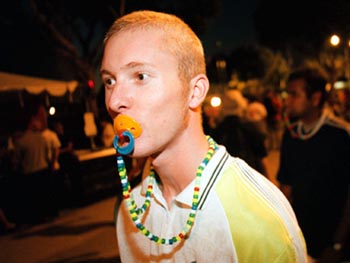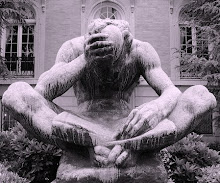
30 January 2009
29 January 2009
Mad Max Beyond the Pillars of Hercules

The Road Warrior (aka Mad Max 2) doesn't get old, I've just begun to realize. I find it interesting that it doesn't because the clothes and hair are so painfully dated and not much happens plot-wise: it's just a loner getting a truck for to good guys to get out of their city with.
But that loner is the one who interests me. Mel Gibson does a nice job of playing a guy who's been alone for a long time (he lost his family and partner in the previous film) and doesn't want to be around anyone else. What's painfully obvious for the viewer is that Max's chosen road is a death sentence: sooner or later, the petrol runs out or he gets himself in a tight spot that even Dog can help him get out of. He's obviously on a treadmill, and the best he can do is maintain. But he's got to be alone--even when he finds a decent partner (the Gyro-copter Captain) and a good sidekick (the feral kid).
In the end, the one I feel sorry for is actually Max because he's left behind--even more alone (he's without Dog now) and more broken down than he was before. He bears his hero status with that poker face, but it's the hero status that keeps him from being a part of the community. The Gyro-copter Captain becomes the leader of that band, and later on the feral kid learns how to talk and leads the band. Max can't do that even though he's more inspirational to those people than any of their other leaders.
I sometimes think this is so because he's not of them, but it's kind of a chicken-or-the-egg situation: he's a hero not a leader because he's not of them? or he's not of them because he's a hero not a leader? The second choice has more to recommend it since the Gyro-copter Captain is not of the community, either. That would seem to suggest that in order to be a hero, the character would have to be separated from the community that he or she is working to protect. Hero's never represent communities--not through synecdoche, metonymy, exemplae, or isotyping. It's usually the leader, the king.
In the medieval and Renaissance periods, you get the "king's body" in the Body Politic metaphor; the nation and land is figured/personified into the symbolic body of the king and the king is reified (to use Paxson's apparently unorthodox definition of the word) into the nation and the land (see the Fisher King for an example). Hero's don't get this, and if they do get something, it tends to be outside of the realm (I'm thinking of the Pillars of Hercules, which mark the outer boundaries of the Mediterranean).
So while the community goes on "2000 miles north" to an Edenic land where "all you have to do is breathe," Max stays behind. Is it any wonder that they're in the Outback? He's out there, the only place he can really be a hero (because if he goes with the community and becomes a leader, he ceases to be a hero), the only place to meet the monsters...
which makes you wonder: just how much of a hero and how much of a monster is Max?
Labels:
heroes,
incoherent rant,
monsters,
movies,
theory
06 January 2009
Pending Orals Prospectus

[Author's Note: This is the version of my Orals prospectus that has now been submitted to the shadowy organization known as the Graduate Committee. Hopefully, it will be accepted--unless they don't like being called a "shadowy organization."]
For years—at least since John Block Friedman’s 1981 book The Monstrous Races in Medieval Art and Thought and Jeffrey J. Cohen’s debut on the scene in the early 1990s—monster theory has been overwhelmingly concerned with reading monsters as marginal figures that demarcate the cultures that create them. Freddy Krueger, Frankenstein’s monster, the Giant of Mount St Michel, the Grendelkin, or Polyphemus mark the boundaries of what is and is not possible. Perhaps more importantly, they serve as outer boundaries of what an individual can or cannot think, speak, or do.[1] In short, they have usually been read as “the primary vehicle for the representation of Otherness in the Middle Ages”;[2] in fact, on this there is a rare and surprisingly widespread consensus.
This widespread consensus, however, has made for an awkward moment in monster theory. Such agreement has left many unsure as to how we should proceed, and some have focused their attentions on other projects. Indeed, conversations with fellow members of the BABEL Working Group such as Cohen, Eileen Joy, and Karl Steel have shown that while monsters are still a source of discussion, scholarly interest in them is beginning to wane in favor of attendant issues (hybridity, sexuality, medieval concepts of the human, etc.). As many who were once heavily involved in monster theory have foreseen, academic agreement quickly becomes academic stagnation. Thus, what was once the study of characters who could petrify with fear is itself in danger of sinking into the swamp and becoming petrified by consensus.
What have not been agreed upon—or even hotly debated—are the functions of monsters as boundary figures. We may agree that as symbols of the Other they demarcate, and we may even agree (though to a lesser extent) on how they go about doing so. But to my knowledge no serious, sustained interrogation has been performed on their function as means of community-formation. Boundary figures by their very nature create an inside and outside. As the Lacanian imago immediately introduces the structural possibility of self/not self, so too does the monster introduce the structural possibility of us/them.[3] This interpretation denies any positivist model for definition, and it is the basis on which Hayden White forms his idea of “ostensive self-definition by negation.”[4] He argues that cultures are largely unable to create an overall definition of what they are and so point to a thing that they are not.[5] Following White’s theory of how the concept of “wildness” served to define “human” or “civilized,” we may read monsters as boundary figures that aid in the creation of a culture’s (negative) definition—of defining what it is by demarcating what it is not.
But how do communities define themselves in this way? What is the process by which they adopt, adapt, or create monsters, and exactly how does this work to strengthen their sense of themselves? It will be the goal of this project to suggest an answer to those questions. As I stated before, the purpose of monsters is understood quite well: they reinforce commonly-held cultural practices—foodways, speech, or ethical precepts—by threatening and questioning them in a fictionalized (and thus circumscribed) manner. I plan on quickly sketching how this process plays out in medieval heroic episodes, both early and late: weapon-use in the case of Beowulf’s Grendel, and sexual mores in Chretien de Troyes’ Harpin. Having established the process by which cultural features are reinforced, I will next turn to Benedict Anderson’s theory of imagined communities in which individuals are part of socially-constructed communities based on specific shared traits. Anderson discusses this in the context of nationalism and its rise, but mutatis mutandis, this theory is will be crucial in exploring how the reaffirmation of a particular value works to strengthen or reconstruct the culture as a whole.
Certainly, such a study moves out of the morass that threatens the future of monster theory, but it is a small step. What I seek to do with this project is to take the first step in a large-scale interrogation of monster theory. By investigating one of the foundational—but largely unquestioned—tenets of monster theory I hope to put a finer point on how it is supposed to work and then, in the dissertation, further the study into instances in which it does not work. To my mind, it is usually the exceptions to the rule that are most instructive as to its limits and application. That is, if monsters always threaten the community and are always Other to it, then (via the structural opposition sketched out above) they always have a negative counterpart. The usual reading of epic, heroic, or romance literature places the hero in this position, but such a reading is reductive and ignores contrary evidence such as Marie de France’s werewolf, Bisclavret, or even Beowulf in his earlier exploits. Rather, it is the king who is the obverse of the monster, and the hero exists as a liminal figure—embodying both the civilized and the monstrous in a way that neither the king nor the monster ever can.
NOTES:
[1] For limits on thought, see Jeffrey J. Cohen’s “The Limits of Knowing: Monsters and the Regulation of Medieval Poplar Culture.” Medieval Folklore 3 (1994): 1-37. For limits on speech, see David Williams’ Deformed Discourse: The Function of the Monster in Mediaeval Thought and Literature. Montreal: McGill-Queen’s UP, 1996. For limits on action, see John Block Friedman’s The Monstrous Races in Medieval Art and Thought. Syracuse: Syracuse UP, 2000. [2] “The Use of Monsters and the Middle Ages.” SELIM: Journal of the Spanish Society for Medieval English Language and Literature 2 (1992): 47-69. p. 49 (Emphasis mine). On this consensus, see also: Noël Carroll, The Philosophy of Horror (New York: Routledge, 1990); Albrecht Classen, “Medieval Answers to the Strange World Outside: Foreigners and the Foreign as Cultural Challenges and Catalysts,” in Demons: Mediators Between This World and the Other, eds. Ruth Petzoldt and Paul Neubauer (Frankfurt: Peter Lang, 1998); Edward J. Ingebretsen, “Monster-Making: A Politics of Persuasion.” Journal of American Culture 21.2 (1998): 25-34; and Franco Moretti, “Dialectic of Fear,” in Signs Taken for Wonders: Essays in the Sociology of Literary Forms, trans. Susan Fischer, David Forgacs, and David Miller. (London: Verso, 1988).
[3] Lacan associates the self/not self split that occurs with Freud’s Innenwelt and Umwelt. See Lacan’s “The Mirror Stage” in Ecrits: A Selection. Trans. Alan Sheridan. New York: Norton, 1977.
[4] Tropics of Discourse: Essays in Cultural Criticism. Baltimore: Johns Hopkins UP, 1978. pp. 151-52.
[5] US Supreme Court Justice Potter Stewart produced a lasting example of ostensive negative definition in 1964. Admitting that he could not define pornography, he then stated “I know it when I see it, and the motion picture involved in this case is not that” (Jacobellis v. Ohio. 378 U.S. 184. Supreme Ct. of the US. 22 June 1964).
Labels:
Arthuriana,
Beowulf,
fear,
Grendelkin,
incoherent rant,
medieval,
monsters,
OE,
poetry,
theory
Subscribe to:
Posts (Atom)

